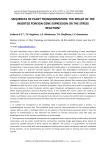Статьи журнала - Журнал стресс-физиологии и биохимии
Все статьи: 1004
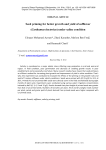
Seed priming for better growth and yield of safflower (Carthamus tinctorius) under saline condition
Статья научная
Salinity is considered as a major abiotic stress affecting crop production in arid and semi-arid region. In field condition, poor germination and decrease of seedling growth results in poor establishment and occasionally crop failure. Many research studies have shown that seed priming is an efficient method for increasing plant growth and improvement of yield in saline condition. That's why; this experiment was conducted to evaluate the effects of KCl priming on the growth traits and yield of Tunisian safflower under salinity conditions. Seeds were primed with KCl (5 g/l) for 24 h at 20°C. Primed (P) and un-primed (NP) seeds were directly sown in the field and followed during eight months of plant cycle. Experiments were conducted using various water irrigations concentrations induced by NaCl (0, 3, 6, 9 and 12 g/l). Results showed that plant height of primed seeds was greater than that of un-primed seeds. Numbers of branches per plant, fresh and dry weight, heads number per plant, petals and grains yield of plants derived from primed seeds were higher compared with un-primed seeds.
Бесплатно
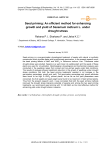
Статья научная
Seed priming is a pre-germination physiological treatment of seeds with natural or synthetic compounds which provides faster and synchronized germination. In the present research work, the seed priming effects of NaCl and KNO3 in Sesamum indicum L.var. Thilothama under drought stress were studied. Sesame is a well known oil yielding plant and the seeds of these plants are used for oil extraction. Morphological, physiological and biochemical analysis were conducted in the seedlings raised from primed and non-primed seeds under field conditions. The results of analyses showed significant reduction in the growth of seedlings under drought stress conditions. But both the seed priming treatments resulted in an increase in the germination percentage, growth and yield. The germination percentage and growth attributes were found to be high in KNO3 primed plants, but as far as the yield parameters were concerned, the fruit weight and seed weight were found to be maximum in NaCl primed plants. Thus from the present research work, it was concluded that both the seed priming methods improved the drought stress tolerance potential of sesame and among the two seed priming treatments, we recommend seed priming with 15 mM NaCl as the most effective method for enhancing yield under drought stress in sesame.
Бесплатно
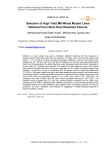
Selection of high yield m6 wheat mutant lines obtained from stem rust resistant parents
Статья научная
Wheat is a major cereal crop grown worldwide. Mutation breeding with the objective to improving grain yield was performed for selection of mutant lines. Dry dormant seeds with approx. 11 % moisture of three Australian genotypes (Mendos, Coorong and Egret) were treated with 100, 160 and 200 Gy Co-60 gamma radiation and mutants were selected between the M1 and M5 generations for yield production under field experimental conditions. Decrease in survival rate (%) of plants was observed. Five seeds from each spike per plant of M1 plants were collected, bulked dose-wise and grown separately as M2. Fifteen promising mutant lines retested in a M5-trial for yield in comparison with the parent cultivars. Significant differences ( P 2) and C-17-31 (976 g/m2) as compared with their mothers and the local control genotype Bouhouth10 (857 g/m2). The obtained results suggest that LD50 (160 Gy) gamma radiation treatment can be useful from breeding point of view for selecting higher yielding wheat plants, and the results showed that the Australian parents had Sr26 resistance gene against stem rust disease caused by Puccinia graminis f. sp . tritici , therefore, their utilization is suggested in wheat breeding programs to achieve resistant cultivars.
Бесплатно
Статья научная
The aim of this pot experiment was to determine the impact of foliar spraying of silicic acid (Si) with or without potassium fertilizer amendment (K) on dry matter (DM), nitrogen uptake (TN), efficient use of N fertilizer (NUE) and pod yield of okra plants ( Abelmoschus esculentus L.) as influenced by salinity in the irrigation water (Salt) using 15N isotope. Results showed that salt stress reduced growth and N uptake by okra plants. Si and/or K applications could reduce the negative effect of salinity to a certain extent depending on the way and the type of applied materials (i.e., separate or combined applications of Si and K). Solely Si application improved okra (DM) and N-nutrition (TN and NUE) under both saline (Salt+) and non-saline conditions (Salt-). This improvement was more pronounced in the former than the latter. However, Si+ did not have significant effect on DM and fresh weights of pods as compared with the control (Si-). Solely applied K fertilizer increased the growth, N uptake and ultimately pod yields. Moreover, the combined use of Si and K could significantly enhance total DM(TDM), TN, amounts of N derived from fertilizer (Ndff), soil (Ndfs) and %NUE in the entire okra plants as well as pod yield. In conclusion, solely applied K or in combination with Si could be considered as an effective agricultural practice to reduce salt stress in okra plants and increase the growth and ultimately pod yields.
Бесплатно
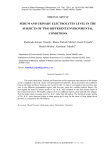
Serum and urinary electrolytes level in the subjects of two different environmental conditions
Статья научная
The serum electrolytes, Sodium and Potassium are the important macronutrient to the human and it is supplied to the body via the solid and liquid food materials. These electrolytes have different roles in the body and these functions are crucial for life. Its rate of consumption and excretion may vary to the different geographical region, and this may cause the variable medical fitness. We investigated the serum & urinary profile of Na+ & K+, and compared it with their dietary intake of these macronutrients in 400 healthy subjects from two different regions, plain and hill. The subjects from the plain region consume more Na+ & K+ rather than hill region. The Serum & urinary profile of Na+ & K+ were observed higher in plain region and it may be the cause of their higher blood pressure as compared to the hill subjects.
Бесплатно
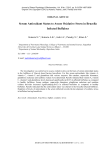
Serum antioxidant status to assess oxidative stress in brucella infected buffaloes
Статья научная
The investigation was carried out to assess oxidative stress on the basis of serum antioxidant status in the buffaloes of Murrah breed having brucellosis. For this serum antioxidants like vitamin A, vitamin C, vitamin E and glutathione and various enzymes like catalase, superoxide dismutase, glutathione reductase and xanthine oxidase were determined. Results indicated that vitamin A, vitamin C, vitamin E and glutathione levels decreased significantly (p≤0.05) in affected buffaloes as compared to healthy buffaloes. Serum catalase, superoxide dismutase, glutathione reductase and xanthine oxidase activities increased significantly(p≤0.05) in affected buffaloes as compared to healthy buffaloes. Results indicated that the antioxidant status was altered in the brucella infected buffaloes. Depletion of levels of antioxidants in the serum reflected towards the development of oxidative stress in buffaloes having brucellosis.
Бесплатно
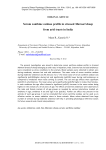
Serum xanthine oxidase profile in stressed Marwari sheep from arid tracts in India
Статья научная
The present investigation was aimed to determine serum xanthine oxidase profile in stressed Marwari breed of sheep belonging to arid tracts in Rajasthan, India. Extreme hot and cold ambiences were considered as stress conditions to the animals. Blood samples were collected to obtain sera during moderate, extreme hot and cold ambiences. The mean value of serum xanthine oxidase during moderate ambience was 93.33±1.11 mU L-1.The mean value of serum xanthine oxidase was significantly (p≤0.05)higher during hot and significantly (p≤0.05) lower during cold ambiences as compared to moderate mean value serving as control. The sex and age effects were significant (p≤0.05) in all ambiences. The mean values were significantly (p≤0.05) higher in males than females. In each ambience the age effect showed a significant (p≤0.05) increase in the mean values being highest in the animals of 2.5-4.5 years of age. The effects of extreme ambiences were observed on the male and female animals of all age groups as revealed by various interactions studied viz. ambience X age; ambience X sex and age X sex (p≤0.01). Further sex effect was present in the animals of each age group. It can be concluded that serum xanthine oxidase can be used as an effective marker to assess oxidative stress in these animals. Mean values obtained from large number of animals during moderate ambience will help in providing physiological reference values for future research and clinical interpretations.
Бесплатно
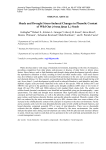
Shade and drought stress-induced changes in phenolic content of wild oat (Avena fatua L.) seeds
Статья научная
Plants develop under a wide range of maternal environments, depending on the time of emergence, prevailing competition from other plants, and presence or absence of other biotic or abiotic stress factors. Stress factors, such as light limitation and drought, during plant development typically reduces the reproductive allocation to seeds, resulting in fewer and often smaller seeds. Such stress factors may also influence seed quality traits associated with persistence in the soil, such as seed dormancy and chemical defense. For this research, we hypothesized that light limitation and drought during wild oat (Avena fatua L.) seed development would result in reduced allocation to seed phenolics and other aliphatic organic acids previously identified in the seeds of this species. Wild oat isolines (M73 and SH430) were grown in the greenhouse under cyclic drought conditions (2005 only) or two levels of shade (50 and 70%; 2005 and 2006) achieved with standard black shade cloth. The soluble and cellular bound chemical constituents were identified and quantified using gas chromatography - mass spectrometry. The shade and drought stress treatments often significantly affected the mass of the caryopsis and hull seed fractions, as well as the phenolic content of these seed fractions, depending upon isoline, seed fraction, phenolic fraction, and specific phenolics analyzed. Phenolic content of the hull was reduced by the stress environments by up to 48%, whereas there was some evidence of an increase in the soluble phenolic content of the caryopsis in response to the stress environments. Ferulic and p-coumaric acids were the most abundant phenolic acids in both soluble and bound fractions, and bound phenolics comprised generally 95% or more of total phenolics. There was no discernable evidence that the aliphatic organic content was affected by the stress environments. Our results indicate that plant stress during seed development can reduce both the physical and chemical defense in seeds, which may result in seeds that are less persistent in the soil seed bank and potentially less of a weed management concern.
Бесплатно
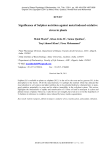
Significance of sulphur nutrition against metal induced oxidative stress in plants
Статья обзорная
Sulphur (S) is available to plants as sulphate (SO42-) in the soil to the roots and as gaseous SO2 in the atmosphere to the shoots. Of all the macronutrient, S is perhaps the nutrient which has attracted the most attention in soil science and plant nutrition due to its potential defensive characteristics to pests, good nutritive potentiality to crops and its relative immobility in the soil-plant system. This review highlights the mechanisms of uptake and translocation of S from soil and its transport in xylem and phloem tissues of plants. Moreover, it also throws new insights, have led us to revisit the hypothesis of S chelation in reference to oxidative stress induced by heavy metals sequestration.
Бесплатно
Silicon root irrigation enhances barley resistance to Fusarium head blight
Статья научная
Silicon (Si) is recognized for its protective role in decreasing disease damage when absorbed by barley plants and has been proposed as a possible solution against Fusarium head blight, associated with devastating agronomic effects on overall yield and grain quality. However, root treatment of exogenous Si irrigating to enhance host resistance to Fusarium infection is unknown. For this purpose, a series of greenhouse experiments was conducted to examine the effects of Si irrigation at 1.7 mM to roots on pathogen development in barley heads. Two barley cultivars with contrasting FHB resistance (moderately resistant Arabi Aswad, AS, and moderately susceptible Arabi Abiad, AB) and infected with four Fusarium species with diverse pathogenicity were used. The quantification of the disease was through the determination of the disease incidence (DI, Type I resistance), disease severity (DS, Type II) and area under disease progress curve (AUDPC) calculated on the basis of DI and DS. Si absorption in barley enhanced the defense system in head tissues to pathogen invasion; FHB developed more severely on AS and AB plants grown without Si irrigation than on plants supplied with Si. Barley plants treated with exogenous Si irrigating were associated with a reduction of up to 19.3%, 19.8%, 18.7%, and 20.0%, respectively, in DI, DS and AUDPC calculated on the basis of DI and DS. Si contributed to the reduction of FHB in barley, especially for the moderately resistant cultivar; however, Si reduced the intensity of FHB in AB to a level comparable with AS. Importantly, Si treatment at 1.7 mM decreased disease damage FHB in previous bio-trials conducted on AS and AB under in vitro and field environments, showing that Si enhanced the expression of resistance to FHB infection in seedlings and adult barley plants. Taken together, the link of Si and host resistance provided a greater decrease in head blight in which both cultivars had augmented performances upon exogenous Si irrigating to roots; highlighting that Si is a potential safe and efficient policy to defend barley when invaded by Fusarium .
Бесплатно
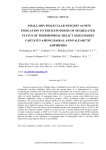
Статья научная
Among the great diverse of Baikal fauna of amphipods (more than 350 species and subspecies) Gmelinoides fasciatus (Stebbing 1899) takes the special place. It is characterized by a high morphological variability and wide thermal-adaptive possibilities. By common opinion G. fasciatus is a thermophilic relict segregated from other Baikal temperature sensitive amphipods' fauna. In present study we tested hypothesis of segregated status of G. fasciatus among some Baikal and some Palearctic amphipods using of heat-shock proteins' (HSP) molecular weight as comparative biomarkers. We used heat-shock proteins (HSP) from two families: HSP70 and small HSP (sHSP) immunochemically related to α-crystalline. 15 species of Baikal amphipods from different genera and families and 2 Palearctic species from genus Gammarus were tested. It was shown, that molecular weights of HSP70 were the same in all investigated species and corresponds close to 70 kD. In the contrast, the molecular weights of sHSP in G. fasciatus was 37 kD and differed from all other species, in which molecular weights of sHSP were 35 kD. In sum, this study showed that sHSPs molecular weights may relate to evolutional differences between the close related species. Additionally, obtained data can be taken as new indication of segregated status of thermophilic relict G. fasciatus which linked with its phylogenetic history in Lake Baikal.
Бесплатно
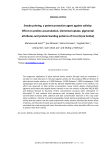
Статья научная
The exogenous application of plant derived smoke solution through seed pre treatment is consider to create tolerance in the plant against salinity, for this purpose different dilution of plant derived smoke solution as 1:5000 Buhania, 1:1000 Buhania, 1:1000 Cymbopogon, 1:500 Cymbopogon were used against 0 mM, 50, 100 and 150mM NaCl solution in the medium. The effect was observed on total proline accumulation, heavy metals uptake, photosynthetic pigments and protein poly peptide bands intensity in two rice varieties as Basmati 385 (B-385) and Shaheen Basmati (S. Basmati). Proline concentration increases while chlorophyll “a” chlorophyll “b” and carotene level decreases with increasing salinity. On other hand zinc concentration increases while cadmium and lead concentration decrease in the crop under saline conditions. Intensity of protein polypeptides bands decreases gradually with increasing salinity level but plants from the seeds soaked with smoke solution alleviate the drastic affect of salinity, and intensity of bands is quite good by comparing with non primed seeds. It is concluded that seed priming with plant derived smoke solution show beneficial effect on crop to protect them from salinity.
Бесплатно
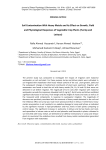
Статья научная
The present study was conducted to investigate the impact of irrigation with industrial wastewater on soil and plant. For these purpose turnip and lettuce plants were cultivated in soil irrigated with wastewater then heavy metals content of the soil, plant growth, yield and the subsequent changes in biochemical constituents of plant were examined. Irrigation with wastewater was found to load the soil with heavy metals (Pb, Co, Ni and Cd) that were not detected in soil before irrigation. The magnitude of Cd in soils after irrigation with industrial wastewater exceeds the maximum allowable limit (3 mg Kg -1). Both turnip and lettuce exhibited significant decreases in leaf area, fresh weight and dry weight of shoots and roots as well as all the measured yield components in response to wastewater irrigation. The magnitude of decrease was positively correlated with the amounts of heavy metals detected in the soil and the inhibitory effect on turnip was much more pronounced than in lettuce. Furthermore, heavy metals accumulation in soil resulted in an oxidative damage to turnip and lettuce as indicated by the significant increase in lipid peroxidation and H 2O 2 levels in both plants comparing to control values. The significant increases in putrescine in lettuce and turnip shoots and roots and spermidine in lettuce roots as well as total phenolics and flavonoids in plants cultivated in soil enriched with heavy metals are believed to be defense mechanisms in turnip and lettuce plants to counteract the oxidative stress resulted from heavy metals contamination generated from irrigation with wastewater.
Бесплатно
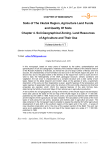
Статья научная
In this monograph, based on many years of research by the author, systematization and generalization of soil and cartographic materials of the Siberian Institute of the Siberian Branch of the Russian Academy of Sciences, as well as the use of a large number of literary and fund sources, the characteristics of soil formation and soil cover in the Irkutsk region are given. It is shown that, due to the great extent of the territory of the region from north to south and from west to east, the heterogeneity of the relief, geological structure, climatic conditions and vegetation, the soil cover is characterized by a complex structure and a wide variety of soil types. Based on the latest research and modern ideas on the genesis of soils, a systematic description of the soils and their diagnostics is given, specific features of the temperature and water regimes of seasonally frozen soils, the structure of the soil profile, physical and chemical properties are reported, which inform the regional features of the soils forming here, determining the fertility of soils and Ways of their rational use in agricultural production. A new scheme for soil-geographical zoning of the territory of the Irkutsk region was developed, which was used as the basis for the soil map of the Irkutsk region at a scale of 1:1 500 000, published by the USSR in 1988. Areas of soil zones, sub-zones and districts were determined and the degree of their agricultural use was indicated. The calculations of the areas of the main types of soils along the soil zones, subareas and districts used in agriculture are given. The data contained in the monograph make it possible to assess the potential for further agricultural development of soils both in the southern regions of the region and in the north - in areas of new industrial construction and in the zone of the western section of the BAM. The work can serve as an explanatory note to the soil map of the Irkutsk region at a scale of 1: 1 500 000, published in 1988. This is the 3-d part of Chapter 4 of the monograph.
Бесплатно
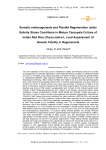
Статья научная
The main objective of this study was to establish the stable and efficient protocol for somatic embryogenesis and plantlet regeneration under NaCl-salt stress conditions in traditional Indian red rice (cv. Poongar) using mature caryopsis as explant and also to assess the genetic fidelity in regenerated plantlets. High frequency (98.88±1.33%) of callogenesis was recorded in MS (Murashige and Skoog, 1962) medium fortified with 10µM of 2,4-D (2,4-Dichlorophenoxyacetic acid) while maximum percentage (95.0±3.9%) of somatic embryogenesis and also maximum number (47.3±3.9) of somatic embryo per callus was recorded in presence of 5µM of 2,4-D alone. Furthermore, maximum frequency (85.33±2.02%) of germination of somatic embryos into plantlets was found in MS medium supplemented with 2.0mg/L of IAA (Indole-3-acetic acid), 3.0mg/L of BAP (6-Benzylaminopurine) and 1.0mg/L of Kn (Kinetin). During the salinity stress treatments, various concentrations (10mM, 25mM, 50mM and 100mM) of NaCl were used in this study in order to induce somatic embryogenesis and plantlets regeneration. Significantly, 100mM of NaCl shows the strong inhibitions for callus induction (26.67±0.63%)and somatic embryogenesis (31.3±1.8%),moreover, weight of the callus was also found to get decreased (94±0.5mg) than control (156±4.3mg) treatment. Interestingly, the highest concentration 150mM of NaCl was proved to be completely inhibitory and function show_abstract() { $('#abstract1').hide(); $('#abstract2').show(); $('#abstract_expand').hide(); }
Бесплатно
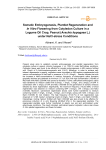
Статья научная
Present study aims to establish somatic embryogenesis and plantlet regeneration from cotyledon culture in peanut ( Arachis hypogaea L. cv. TMV13) under NaCl-stress conditions. Cotyledon tissue was found to be efficient for somatic embryogenesis in MS medium fortified with 10mg/L of 2,4-dichlorophenoxyacetic acid (2,4-D). Moreover, in order to achieve salt-tolerant regenerants in peanut, cotyledons were inoculated on MS-medium supplemented with various concentrations of NaCl-salt in presence of 2,4-D (10mg/L). Results indicate that with the increase in NaCl-concentrations in medium, frequency of embryogenic callus formation gradually declines and obtained as minimum (17.1±0.16%) with high concentration (150mM) of NaCl-salt while NaCl (200mM) was proved to be lethal. Further, salt-tolerant embryogenic callus was transferred to medium added with (0.5mg/L, 1.0mg/L, 1.5mg/L, and 2.0mg/L) of BAP in combination with (1.5mg/L) of IAA and NaCl (100mM) for the germination of somatic embryos followed by shoot regeneration. Significantly, the maximum frequency (70.2±0.59%) of shoot regeneration was obtained on medium containing BAP (1.5mg/L), IAA (1.5mg/L) and NaCl (100mM). Moreover, salt-tolerant regenerated shoots were further transferred to medium containing kinetin (1.0mg/L, 2.0mg/L, 3.0mg/L, and 5.0mg/L) along with NAA (1.5mg/L) and NaCl (100mM) for root initiation. The high frequency (51±0.7%) of root regeneration was observed on ½ MS medium containing kinetin (2.0mg/L), NAA (1.5mg/L), and NaCl (100mM). Interestingly, rooting medium fortified with NaCl (100mM) was also proved to be effective for precocious induction of in vitro flowering (26.66±0.12%) in the regenerated plantlets. The regenerated plantlets were further transferred to plastic cup soil and acclimatized under greenhouse conditions. The result indicated, salt-tolerant peanut cotyledon culture also shows In Vitro plantlet regeneration and flower formation.
Бесплатно
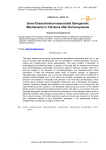
Some desacarisation-associated sanogenetic mechanisms in chickens after dermanyssosis
Статья научная
The paper presents some natural supramolecular sanogenetic mechanisms that occur in the body of chickens after dermanyssosis with the participation of stress-associated hormones, cortisol and triiodothyronine, during desacarisation. This study contains a description of physiological and biochemical bases of recovery of the body after an extreme environmental factor (haematophagous ectoparasite Dermanyssus gallinae ). Particular scientific interest is in studying changes in the dynamics of morphophysiological and biophysiochemical blood parameters in birds with eliminated stress factor of extreme strength, an aggressive haematophagous ectoparasite, and a concurrent desacarisation of the poultry building with a synthetic pyrethroid-based drug. At the same time, partially normalized key parameters of endocrine and metabolic homeostasis was detected in the birds after dermanyssosis, which occurred due to activated natural sanogenetic mechanisms, and compensatory and adaptive reactions. Significant changes were detected in the hormonal state in the chickens from the experimental group that resulted in the decreased cortisol-producing function of the adrenal glands and the increased thyroid gland functional activity. The latter is, in our opinion, the most important sanogenetic mechanism that ensures maintenance of the antioxidant status, which is especially necessary when the body recovers after an extreme environmental factor. Along with this, a natural recovery of the RBC elements as well as immunity was observed. At the same time, decreased intensity of lipid peroxidation processes in the experimental chickens predetermines maintaining the integrity of these cells.
Бесплатно
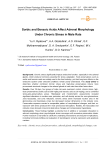
Sorbic and benzoic acids affect adrenal morphology under chronic stress in male rats
Статья научная
Background: Chronic stress significantly impacts endocrine function, especially in the adrenal glands, which produce hormones essential for stress adaptation. Food preservatives such as sorbic and benzoic acids are widely used in the food industry, yet their long-term effects on the endocrine system under stressful conditions remain poorly understood. This study aimed to determine whether combined chronic stress and high-dose preservatives induce more pronounced structural changes in the adrenal glands of male rats than either factor alone.
Бесплатно
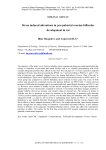
Stress induced alterations in pre-pubertal ovarian follicular development in rat
Статья научная
The objective of the study was to find out whether stress experienced during neo-natal period alters the timing of formation of pre-antral and antral follicles and if so, whether pre-treatment with CRH receptor antagonist prevents these effects in rats. New born rat pups (n= 15) were exposed to maternal separation (6 hours/ day) from post-natal day (PND) 1 to 7 and were killed on PND 8, 11 and 15. The time of exposure was randomly changed every day during light phase (7Am to 7Pm) of the day to avoid habituation. There was a significant increase in serum corticosterone levels on PND 8 and 11 in stress group rats compared to controls indicating stress response in these pups. The ovary of both control and stressed rats contained oocytes and primary follicles on PND 8 and 11 and in showed progress of follicular development upto to pre-antral and early antral follicle formation on PND 11 and 15. However, mean number of healthy oocytes and all categories of follicles at all ages studied were significantly lower in stressed rats compared to controls. Concomitant with these changes, number of atreatic follicles showed an increase over control values in stressed rats. The increase in atresia of follicles was due to apoptosis as shown by increase in the percentage of granulosa cells showing TUNEL positive staining and caspase 3 activity. On the other hand, pre-treatment with CRH- receptor antagonist (CRH 9-41) 2ng/ 0.1 ml/ rat prior to undergoing stress regime on PND 1 to 7, prevented alterations in pre- pubertal follicular development thereby indicating that the ovarian changes were due to effects of stress induced activation of HPA axis. The results indicate that, stress during neonatal phase, though does not affect timing of formation of pre-antral and antral follicles, it does enhance atresia of follicles of all categories, including follicular reserve, which may affect the reproductive potential of adults. The results, for the first time reveal that CRF receptor antagonist prevents pre-pubertal ovarian stress response.
Бесплатно

